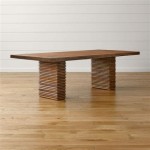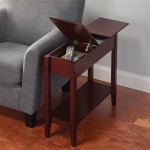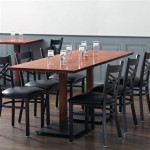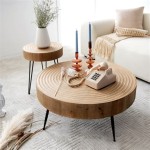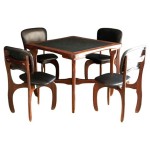Round Table With Leaf and Chairs: Exploring Functionality and Design
The round table, a classic furniture piece often associated with collaboration and equality, gains enhanced functionality and aesthetic appeal when combined with a leaf and accompanying chairs. This configuration allows for adaptability, catering to both intimate gatherings and larger assemblies. Understanding the nuances of design, materials, and usage scenarios is crucial when selecting a round table with a leaf and chairs for any space, be it a dining room, conference room, or a multi-purpose area.
The fundamental characteristic of a round table is its circular shape, which inherently promotes conversation and a sense of shared participation. The absence of a head or foot removes traditional hierarchies, fostering a more egalitarian atmosphere compared to rectangular or square tables. When a leaf is incorporated, the table's capacity can be significantly expanded, making it a versatile solution for accommodating fluctuating needs. Chairs, of course, are integral to any table setup, and their design should complement both the table's aesthetic and the intended purpose of the space.
Understanding the Mechanics and Benefits of the Leaf Extension
The leaf mechanism is the defining feature that distinguishes a round table with a leaf from a standard round table. The leaf, typically one or more sections of tabletop material stored separately, is designed to be inserted into the center of the table, effectively increasing its diameter and transforming it into an oval or elongated shape. The insertion process varies depending on the table's design but commonly involves separating the two halves of the round tabletop along a central seam, revealing a space where the leaf can be secured.
There are several types of leaf mechanisms. Some tables utilize a butterfly leaf, which is hinged and folds out from beneath the tabletop. Others employ a drop-in leaf, which is a separate piece that is simply inserted into the gap. The choice of mechanism impacts the ease of use and the table's overall structural integrity. A well-designed leaf mechanism should be smooth, secure, and unobtrusive when the leaf is either in use or stored. The mechanism should also ensure that the inserted leaf sits flush with the existing tabletop, creating a uniform and aesthetically pleasing surface.
The primary benefit of a leaf extension is its adaptability. It allows a single table to serve multiple purposes, from intimate dinners for two or four to larger gatherings of six, eight, or even more. This flexibility is particularly valuable in homes or spaces where space is limited. Instead of needing multiple tables of different sizes, a round table with a leaf can adapt to the specific needs of the moment. Furthermore, the ability to store the leaf separately provides additional space-saving advantages when the larger table size is not required.
Beyond mere practicality, a well-integrated leaf extension can also enhance the table's aesthetic appeal. The transition between the original tabletop and the inserted leaf should be seamless, maintaining the overall design integrity. Matching the grain, color, and finish of the leaf to the existing tabletop is crucial for achieving a cohesive and visually appealing look. Some manufacturers even offer contrasting leaf designs, which can add a unique design element to the table.
Material Considerations: Durability and Aesthetics
The materials used in the construction of a round table with a leaf and chairs significantly impact its durability, aesthetics, and overall cost. Common materials include wood, metal, glass, and various composites, each with its own set of advantages and disadvantages. The choice of material should be carefully considered based on the intended use of the table, the desired aesthetic, and the budget constraints.
Wood is a classic and versatile material that offers a wide range of options in terms of grain, color, and finish. Hardwoods like oak, maple, and cherry are known for their durability and resistance to wear and tear, making them ideal for high-use tables. Softwoods like pine and cedar are more budget-friendly but may be more susceptible to scratches and dents. The finish applied to the wood can also significantly impact its appearance and durability. Options include varnish, lacquer, oil, and wax, each offering different levels of protection and sheen.
Metal is another popular choice, particularly for the table base and chair frames. Steel and aluminum are commonly used for their strength and durability. Metal can be finished in a variety of ways, including powder coating, painting, and polishing, to achieve different aesthetic effects. Metal bases can provide a modern and sleek look, while also offering excellent stability and support.
Glass tabletops offer a contemporary and elegant aesthetic. Tempered glass is a common choice due to its strength and safety. While glass is relatively easy to clean, it is susceptible to scratches and fingerprints. Glass tabletops can be paired with wood or metal bases to create a visually striking contrast. However, glass leaf inserts can be problematic due to weight and storage considerations.
Composite materials, such as MDF (Medium-Density Fiberboard) and plywood, offer a cost-effective alternative to solid wood. These materials are often used for the tabletop and leaf construction, particularly in budget-friendly furniture pieces. While composite materials are generally less durable than solid wood, they can be finished to resemble wood and offer a consistent surface for painting or laminating. The edges of composite materials are typically covered with veneer or edging to prevent moisture damage and improve their appearance.
Chair Selection: Complementing the Table's Function and Style
The chairs accompanying a round table with a leaf are just as important as the table itself. The chairs should be comfortable, functional, and aesthetically complementary to the table's design and the overall style of the space. Considerations include the chair's height, back support, material, and style. The number of chairs should also be appropriate for both the unextended and extended configurations of the table.
Chair height is crucial for ensuring comfortable dining or working. The ideal distance between the seat of the chair and the tabletop is typically around 12 inches. This allows for ample legroom and prevents slouching. When selecting chairs, it is important to measure the height of the table and ensure that the chairs are appropriately sized.
Back support is another important factor to consider, especially for chairs that will be used for extended periods. Chairs with high backs provide more support for the upper back and shoulders, while chairs with lower backs offer more freedom of movement. The curvature of the backrest should also be ergonomically designed to support the natural curve of the spine.
The materials used in the chair's construction should complement the materials used in the table. Wooden chairs pair well with wooden tables, while metal chairs can create a modern contrast. Upholstered chairs offer added comfort and can introduce color and texture to the space. The upholstery fabric should be durable and easy to clean, especially if the chairs will be used in a dining setting.
The style of the chairs should be consistent with the overall style of the table and the space. Traditional tables often pair well with classic wooden chairs, while modern tables can be complemented by sleek metal or plastic chairs. Mixing and matching styles can create a more eclectic and personalized look, but it is important to ensure that the different elements work together harmoniously.
Finally, the number of chairs should be appropriate for both the unextended and extended configurations of the table. When the leaf is not in use, the chairs should be evenly spaced around the table, allowing for comfortable seating. When the leaf is inserted, additional chairs may be needed to accommodate the increased capacity. It is important to have enough chairs available to comfortably seat all of the guests or participants.
In summary, a round table with a leaf and chairs represents a versatile and adaptable furniture solution. The careful consideration of the leaf mechanism, materials, and chair selection ensures both functionality and aesthetic appeal, allowing for seamless integration into a variety of spaces and usage scenarios.

Solid Wood Foldable Round Table

Bonnet Modern Extendable Round Dining Table Walnut None

Bonnet Modern Extendable Round Dining Table Walnut None
Dining Table Mid Ancient Style Solid Wood Round Setdinning Modern Simple Set

Caroline Circle Dining Table Embrace Modern Elegance Comfy Sg

Fleur Extending Round Dining Table 4 Chairs Old Creamery Furniture

Paris Modern Round Solid Wood Dining Table 150l X 150w 75h

Nordic Round Dining Table Set 2 1

Nero Extendable Sintered Stone Round Dining Table And Chairs Singapore

Urtr 5 Piece Natural Wood Top Round Dining Table Set Extendable Kitchen And 4 Upholstered Chairs For Person T 01421 E The Home


